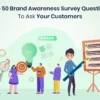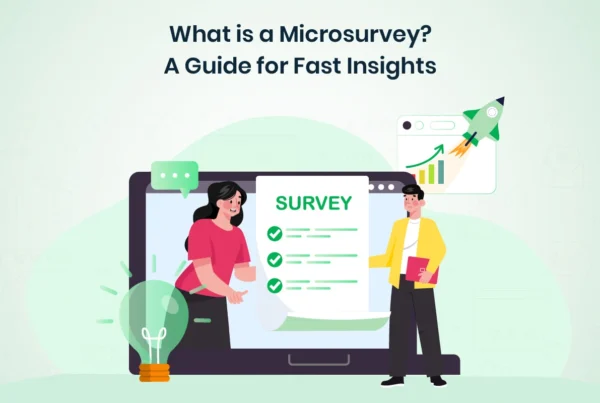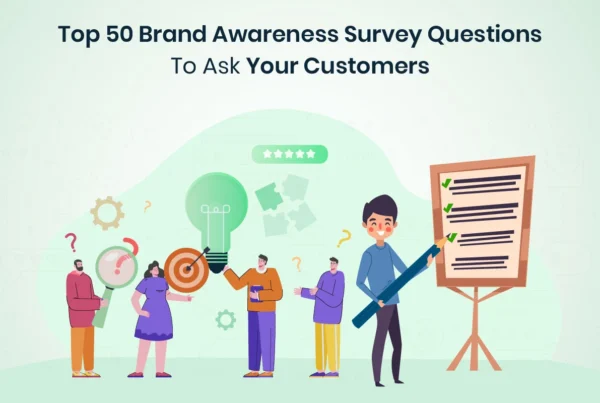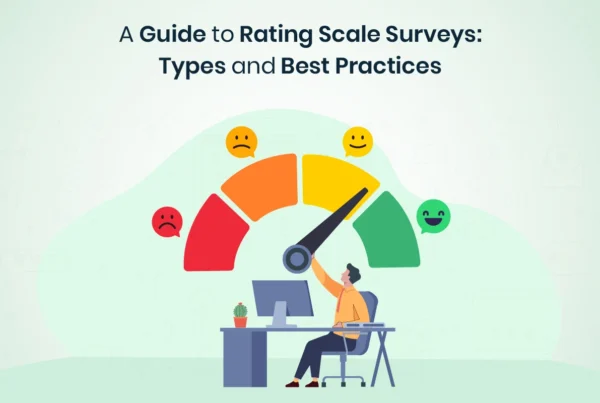Customers are the heart of any business. Understanding the needs, opinions, and pain points of customers is essential to retain them and ensure they are satisfied. How to know what customers are thinking? That is why surveys exist.
But then again, there is another problem that businesses face: Which type of questions to ask? When it comes to survey questions, there are two primary types: closed-ended and open-ended questions.
In this blog, we will explore what closed ended questions are, how they differ from open-ended questions, different types of closed questions, and more.
What are Closed Ended Questions?
Closed questions are questions used in surveys that feature predefined and limited number of responses. People need to select their response from these structured options. The options can range from 2 (dichotomous questions) to 10 and more (rating scale questions).
The primary benefit of closed-ended questions is that they are short and take less time to answer, which further increases the response rate. It is easy to analyze the responses as the options are predefined and relatively specific.
Open-Ended Questions vs Closed-Ended Questions
Here is a quick summary of closed-ended vs open-ended questions:
| Parameter | Closed-ended questions | Open-ended questions |
| Type of data collected | Quantitative data | Qualitative data |
| Level of detail | Crisp, short, specific, and on-point responses | Refined, in-depth, and diverse responses |
| Type of responses | Fixed and predefined responses | No fixed responses |
| Format | Structured framework | Unstructured framework |
| Best for | Best for measuring attitudes and opinions and gathering quantitative data | Best for understanding complicated issues and the detailed reasons behind quantitative data |
Open-Ended vs Closed-Ended Questions: Which is Better?
If you simply want to know the opinions of your customers about a specific topic, closed-ended questions are the most ideal. However, if you want to learn the reasons behind the why of customers’ responses, open-ended questions are better.
11 Different Types of Closed-Ended Questions with Examples
In this section, we will discuss different types of closed-ended questions with examples:
1. Yes/No Questions
As the name suggests, these questions have yes and no as the only options. Respondents simply have to choose between yes and no. These questions are great when you want to screen or verify something from the respondents.
Examples:
1. Did you like our product or service?
- Yes
- No
- Have you ever participated in a survey?
- Yes
- No
- Do you think ParamInfo offers better services than its competitors?
- Yes
- No
2. Dichotomous Questions
Questions that feature only two options are called dichotomous questions. Yes/no questions are a type of dichotomous question as they consist of only two options, usually yes and no.
The options for dichotomous questions can vary, such as agree-disagree, like it-hate it, good-bad, thumbs up-thumbs down, and more. These types of closed-ended questions usually provide clear, straightforward feedback. The answer is either this or that, which is why analyzing these questions is relatively simple.
Examples:
- Do you agree with this statement? piLobi is the best visitor management software.
- Agree
- Disagree
- How was your experience with our product?
- 👍
- 👎
- What do you think about the recently added feature to our service?
- Love it
- Hate it
3. Multiple Choice Questions
Multiple choice questions are quite flexible and feature several options from which respondents need to select. Generally, these questions have 4 options and people can choose one or more. When you want to gather broad feedback from the respondents, it is best to consider adding multiple choice questions in the survey.
Examples:
- Which feature/s do you like the most about our survey software?
- Ease of use
- Advanced dashboard and analytics
- Real-time reports and monitoring
- Affordability
- How did you find us?
- Search engine
- Social media channels (Instagram, X, Facebook, etc.)
- Word of mouth
- Which of the following are you familiar with?
- Option A
- Option B
- Option C
- Option D
- Option E
4. Rating Scale Questions
Coming to the rating scale questions, these questions ask respondents to rate something. The rating can be done based on numerical values, smiley emojis, stars, and more. Depending on the satisfaction level of the people, the rating will vary.
There are various types of rating scale questions, which include:
- Likert Scale Questions
- Star Rating Questions
- Smiley Rating Questions
- Numerical Rating Questions
5. Likert Scale Questions
Likert scale questions are asked to know to which extent the respondent agrees or disagrees with the given statement. The responses are usually 3, 5, and 7 points. They include strongly agree to strongly disagree, highly satisfied to highly unsatisfied, very likely to very unlikely, and more.
Example: On a scale of 1 to 5, can you rate your level of satisfaction with our application engineering services?
- Not satisfied at all
- Somewhat unsatisfied
- Neutral
- Somewhat satisfied
- Completely satisfied
6. Star Rating Questions
These questions allow respondents to rate their satisfaction level using stars. These questions are best when asking about product ratings, service ratings, customer experience, etc.
Example: How would you rate your experience with our customer support representative?
- ⭐⭐⭐⭐⭐
- ⭐⭐⭐⭐
- ⭐⭐⭐
- ⭐⭐
- ⭐
7. Numerical Rating Questions
Numerical rating questions ask the respondents to rate their response using the given numerical scale, which contains 11, 10, 7, or 3 points. For instance, if they are satisfied with the product, they will give a 9 or 10 and vice versa.
Example: How likely are you to recommend PiLobi to your clients?
| 1 | 2 | 3 | 4 | 5 | 6 | 7 | 8 | 9 | 10 |
Highly unlikely Highly likely
8. Smiley Rating Questions
With smiley rating questions, people can respond to the question using the given emojis. Smile rating questions usually feature 3-point, 4-point, and 5-point responses, which typically mean excellent, good, average, bad, and worst.
Example: How would you rate the hybrid working model newly implemented at our office?
- 😍
- 🙂
- 😐
- 🙁
- 😡
9. Rank-Order Questions
For rank-order questions, respondents need to rank the given responses based on their priority.
Examples:
- When choosing an IT support company, rank the aspects below based on their importance to you.
- Expert team and broad services
- Affordable services
- Clear communication and transparency
- 24/7 support
- Please rank the apps based on how often you use them.
- Online banking apps
- Spotify
10. Checklist or Checkbox-Style Questions
When answering checklist or checkbox questions, respondents need to choose more than one response. The responses are usually featured in a box and people simply need to tick the boxes based on what their response is.
Example: When traveling, what are the essential items you bring with you?
- Clothes
- Toiletries
- Medicine kit
- Camera
11. Drop-Down Questions
Drop-down questions show the options when people click on the question. There will be numerous options, but the respondent needs to choose only one. These questions are great for saving space in the survey design template.
Example: Choose your age from the given options.
- Under 11
- 11 to 18
- 19 to 29
- 30 to 45
- 46 to 54
- Above 55
Best Tips to Follow When Using Closed-Ended Questions
Here are a few tips you can follow when using closed-ended questions in a survey:
- Always keep questions crisp, short, and simple. Do not use technical jargon and stick to everyday language so people can understand them easily.
- Add a skip logic condition in the survey so people can skip anything irrelevant to them.
- Rather than using only one type of question format, use different types of closed-ended questions, such as rating scale, multiple choice, dichotomous, and more.
- Do not add the same options in the same format for every question. Jumble the responses to every question so people do not select the same option every time.
- Provide a wide range of options so respondents can choose the option/s that applies to them. If possible, add a not applicable or none of the above option as well.
- Pay attention to the survey length and ensure it is not too long.
In a Nutshell
Closed questions are great for quickly gathering the opinions of customers on certain things you want to know about, be it their level of satisfaction, awareness level, and more. These questions consume less time and are easy to answer as they come with predefined options. You can use this quantitative data to enhance your products/services, improve customer satisfaction, and drive business growth.
Use piHappiness to conduct surveys. There are free templates with different closed-ended questions that cater to various industries. The best part? You can customize the survey design, questionnaire, etc. If you are interested, do not forget to try our 14-day free trial and enjoy the advanced features.
![Guide to Closed Ended Questions [Types and Examples]](https://www.pihappiness.com/wp-content/uploads/2024/12/Close-ended-questions.webp)







